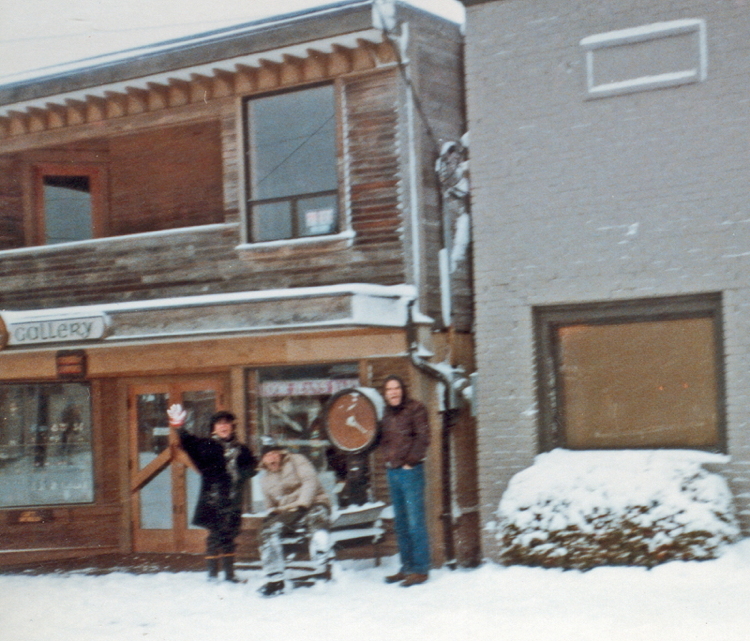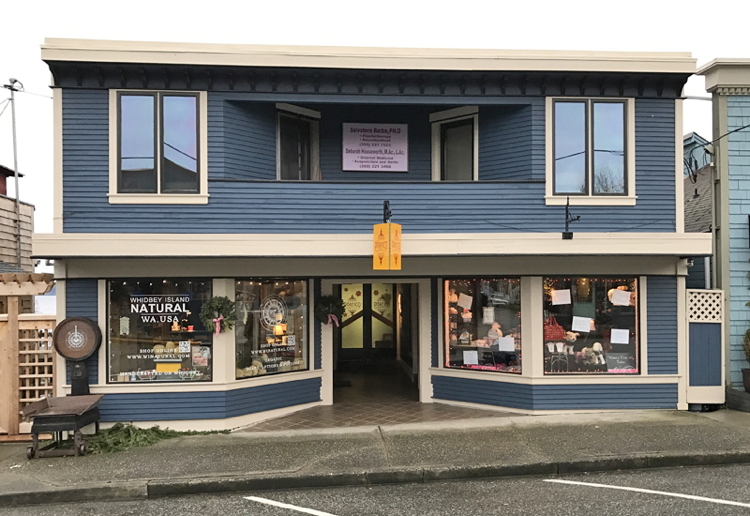220 First Street
Whidbey Island natural / Portico / Counseling / Swanky Dog / Meat Market / Bakery / Gallery / Buisness and Offices
Circa 1906: First Meat Market

Circa 1907. North side of First Street (Courtesy Karen Pauly).
Businesses along the north side of First Street in 1906 included the "Palace of Sweets" ( a confectionary and pool hall), a meat market, barbershop, blacksmith shop, and livery stable.
The butcher, Henry Weber, lived in the back of the Meat Market and was never seen without an old sweater and bloody apron. The housewives swore that he weighed his hand with every sale. His nose was large, red and deeply pitted. His thin hair was white and, when he peered through his smeary, steel rimmed spectacles, he could have been Langley's best loved Santa Claus - if he hadn't held his meaty hand on the scale.
Of course, there was no refrigeration, so all the meat hung in the open, except the wieners that lay in a half barrel, partly covered with white fat. Some flies were around, since the greasy screen door hung in flaps and tears.
The old butcher's meat came from Everett by boat, so, although much maligned, his was the only game in town. He managed to make ends meet and keep a bottle around, from which he nipped regularly, throughout the day. 'Iss kalt in das shop,' he'd explain, as he stuffed it back in its hiding place. (William McGuinnis).

Circa 1914. Buildings on the north side of First Street. First Street (Courtesy South Whidbey Historical Society).
The Olympic Club, built next to the Palace of Sweets in 1908, became the Langley Mercantile and Post Office in 1912. It shared an awning with the Palace of Sweets. Not to be outdone, the adjacent Meat Market also sported an awning.
"Down the street, next door to the meat market, sat a little yellow building with a lean-to attached at the back. In front was a candy cane barber pole. Bill Foster was the first proprietor I knew, but others followed, as their fortunes ebbed and flowed.
"Elmer 'Skinny' Rothgeb was the hair butcher when the athletic club was in full swing. 'Skinny' was a little on the plump side, red haired and with a very florid complexion to match. Saturday was a big day at the barbershop because Saturday night was a dance night. For a dollar, a young logger could buy a haircut, shave and a bath and come out with his hair slick and smelling loudly of bay rum. There was a woodstove in the lean-to with a wash basin, boiler and kettles for heating water." (William McGuinnis).
Circa 1935: New Meat Market.

1943. Primavera girls on First Street in front of the Langley Meat Market (Courtesy Anna Primavera).
A new, larger, meat market was built next to the former blacksmith shop. The butcher Edward Wallace Christoe and his family lived behind the butcher shop. There was a board walkway back into their quarters. (Frances Johnson).
Betty Hensley and her mother, who lived in Langley from 1928 to 1939, were considered poor. They qualified for the meat from deer that were killed on the roads. "If you didn't report a killed deer, you could be fined. But, if you reported it, you could retrieve it and take it to the meat market." (Betty (Hensley) Daniels).
In 1942, the "Langley Meat and Cold Storage" was run by Herman Walters. John McLeod worked in the meat market for Herman Walters for about 2 months delivering meat to people on the south end of the Island in a 4-cylinder, Ford van. He left after 2 months when they couldn't agree on a contract.
1948: Frear buys the Meat Market

1960. Bob Frear in apron in front of his Meat Market (Courtesy Darrell Corbin)
From 1948 to March 1971, Bob Frear owned and operated the "Langley Meat and Cold Storage." "Frear started out as an apprentice butcher in Seattle in 1912." Bob's family had settled near Lone Lake in 1920, and Bob worked for the Lynden Poultry Company and later for the Cooperative Egg and Poultry Association. He married May Bainter in 1930, and they started their own chicken business on property between Park and DeBruyn. He closed the meat market in March, 1971.
After Bob Frear retired, Ben Reams then ran the business for a few years He tried to create an "old-fashioned Meat Market." He "redecorated his shop with antiques and provided a small coffee shop." "He gives free shopping bags to his customers and plans to buy an old truck and paint a sign on it. Ben's Butcher Shop, Free Delivery." (Seattle Times, 1973).
"They had this old compressor back there that was a refrigeration unit for fish. You could rent lockers there. There was a double row of them. They had little flaps with hinges - like slatted gates that you could put a padlock on." (John Norby) "You'd stick your stuff in there. If you were short, you couldn't see your stuff in the back." (Sandy Izett).

1975. North side of Ben's Butcher Shop (Courtesy Langley City Hall).
When Ben Reams had the Meat Market, Gary Piper painted a sign on the north side of the building so it could be seen from the water.
When Ben gave up there store: "Alex McDonald took it over. He ran the meat market for a time as simply as a storage unit. He got new refrigeration stuff, but he was an academic and didn’t really know much about it. Eventually, the unit would fail and he'd have to rush off to get new stuff. It eventually frosted up. People's food was rotting. They had to knock it down and clean it up. The building was totally gutted." (John Norby).
Lonna and Art Parker had the building next. They remodeled the front of the meat market and added a second floor. The original meat market was in back. the deed specified that the large meat market scale was to be placed on the sidewalk for hunters to weigh their deer and tourists to weigh themselves. Lonna had a gallery upstairs, and Ron Childers and Richard Proctor had their first gallery there before moving into the old post office building a few doors away in 1983.
1977: Daily Bread Bakery

1978. Daily Bread Bakery (Photograph by Gary Whitcomb in "Island Views," 1978).
Bruce Dobson and Laurie (now Davenport) moved their "Daily Bread" Bakery from Clinton to Langley. They initially occupied the back portion of Brian McKenna's "B-Street" on First Street before moving across the street into the former meat market building from 1977 to 1982.
1980's Building remodeled.

1985. Former meat market (left) (Courtesy Brian McKenna)
Steve and Cathy James remodeled the building in the 1980's. There were two shops in front and one (an antique store) in back.

2004 Virginia LaRue’s "Cascadia Nauticals" in the rear and "Virginia's Too" on both sides of the front. (Courtesy Robert Waterman).
Virginia LaRue had three antique shops in the remodeled building; "Cascadia Nauticals" in the rear, and "Virginia's Too" in both front spaces. The Enchanted Eagle "was Southwest Indian art by and large. It was there a couple years, then she went away one night" (Josh Hauser).
Other businesses that occupied the building in the 1980's included the "Herron," and "Litlstuff."
The building was purchased from Cathy James by Cheryl Keefe in 2014. The old meat market scale that was initially placed on the right side, was moved to the left side of the building for aesthetic reasons.

2016. Current home of the "Portico” Restaurant in the rear," Whidbey Island Natural" and "Swanky Dog" on the ground floor, and counseling offices above (Courtesy Robert Waterman)
cupcake shop occupied the right hand space for a short time before being replaced by the Swanky Dog.